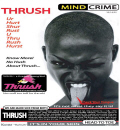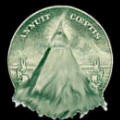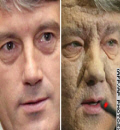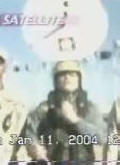Let's further suggest that, for maximum flexibility, each quantum dot is controlled by 16 electrodes with independent voltage sources. This means 16 separate conductor traces feeding into the chip for each of our several billion dots. That's a lot of wires, and a lot of independent voltage sources. Impractical? An obvious simplification is to break the grid up into smaller "tiles," say groups of 8 by 8, or 64, quantum dots. Each dot on a tile would be controlled independently of the others, but each tile of 64 would behave the same as every other tile. The 16 voltages controlling any given dot are also passed along to the same location in the neighboring tiles. Thus, only 1,024 different voltages (16 by 64) are needed to control a tile-floor chip of arbitrary size.
This may sound like a limitation, but if each
electrode can be set, for example, to 256
discrete voltages, each designer atom will have
25616, or 3.4 x 1038 possible states. Compared
with the 92 states of the periodic table, this
is a staggering number, and if we place three
designer atoms together, the number climbs to 10
quadrillion googol, or 1.02 x 10115 - higher
than most calculators can count. So an 8 by 8
grid - more than 21 times as large - represents
an absurd and downright spooky wealth in
undreamed-of materials. Finding needles in that
cosmic-scale haystack will be the work of
lifetimes. Controlling the chip itself, however,
is relatively easy: With only 1,024 signals to
worry about, our only problem is splitting and
routing these to the individual quantum dots.
Laying a few hundred of these chips side by side
will result in exactly what I promised earlier:
a TV screen that changes substance as easily as
it changes color. With minuscule power
consumption, it could easily switch from lead to
gold and back again, many times a second. And
since it isn't limited to the 92 natural
elements, it would be capable of taking on
characteristics that natural substances can't.
It's a reasonable bet that there'll be better
superconductors than today's yttrium barium
copper oxides, better reflectors than the
mercury and silver we use today, better
photoelectric converters than silicon. In
fiction, I've even posited the existence of
programmable matter "superreflectors" and "superabsorbers,"
which process light in a given frequency band
with 100 percent efficiency.
They won't change mass
or shape. But with the flick of a bit,
artificial atoms will change from one miraculous
pseudosubstance to another.
Really, such chips would be capable of doing and
being so many things that it's easier to start
from the other end and list their limitations.
They can't change their mass. They can't change
their shape, although they can be mounted on the
surface of something that can. They also can't
self-replicate, although they can presumably be
mass-produced by a sufficiently advanced
nanotechnology. Also, while their chemical
properties are real, they're not straightforward
- the atoms of the semiconductor substrate don't
simply go away. At best, you'll have an
atomically thin programmable layer sitting on a
bed of silicon or gallium arsenide. At worst,
you'll have discrete programmable islands
jutting up from the substrate like stones in a
Japanese garden.
Too, since their electron orbitals are about 50
times larger than those of natural atoms, they
won't interact with natural atoms in a natural
way. Clever choice of quantum dot settings could
allow bonding between artificial and natural
atoms, but even so, the spacing of the dots is a
major limitation. For example, we could tile the
chip's surface with ersatz glucose molecules,
but these would be so big our taste buds
wouldn't recognize them. Still, if we really
want the chip to taste sweet, or sour, or like
filet mignon, future engineers may find some dot
settings to approximate it.
Wellstone: A Logical Endpoint
A final, important shortcoming of this
technology is its lack of 3-D structure. The
programmable layer is a nanoscopically thin
veneer on the surface of the chip, capable of
mimicking only two-dimensional molecules. This
rules out the vast majority of organic
substances, inorganic crystals, and nanomachine
components. You can't command a diamond coating
to appear on the chip, or even a quartz one.
Fortunately, this limitation also has a
solution: We roll the chip into a long, thin
fiber. With the P-N-P layers of the quantum
well, the conducting traces on top of them, and
the memory and insulation layers beneath, this
fiber would have a minimum diameter of about 60
to 80 nanometers (300 to 400 atoms), meaning we
could fit 10 to 13 artificial atoms around its
circumference and a potentially infinite number
along its length.
Once we have these fibers, we can string them up
in a 3-D lattice not unlike the skeleton of a
building, or else weave them together tight as
basket wicker. This is a tough nano-assembly job
either way, but once it's complete we have
artificial atoms bumping right up against one
another, able to bond with neighbors on the same
fiber and/or adjacent fibers. Now we can create
not only a thin film of goldlike pseudomatter
but a three-dimensional solid with the mass of
wickered silicon but the physical, chemical, and
electrical properties of an otherwise-impossible
gold/silicon alloy. Or mixtures of other
metallic or nonmetallic substances, including
the "unnatural" and "impossible" ones discussed
above. And with the flick of a bit, the voltages
on the quantum dots can be altered, to change
the solid from one miraculous pseudosubstance to
another.
In a discussion on this subject in the summer of
1998, Gary E. Snyder of Pioneer Astronautics and
I coined the name "quantum wellstone" (or simply
"wellstone") to describe this hypothetical but
plausible form of programmable matter. It's a
term that has served me well in my fiction.
As for the material's mechanical strength, the
bonding between quantum dots on the same fiber
is limited by their spacing, which is a function
of how small we can reasonably make the fences.
These bonds will be weak: at best, about .0025
percent as strong as a 5-ev carbon bond. If you
programmed in a bunch of carbonlike atoms, you'd
get back a sort of watered-down diamondoid
crystal. The bulk properties of such a material
are difficult to estimate, but they're probably
quite different from both silicon and carbon, in
the same way fiberglass is different from bulk
SiO2 and polymer resin. And remember, we have an
infinity of electron patterns to play with, so
if we don't like the properties we end up with,
we can simply adjust them.



.jpg)

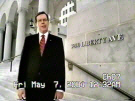

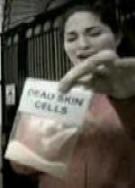

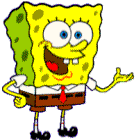


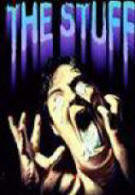
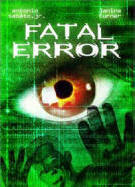
.jpg)








